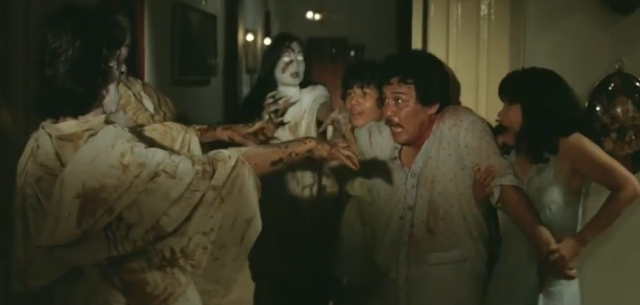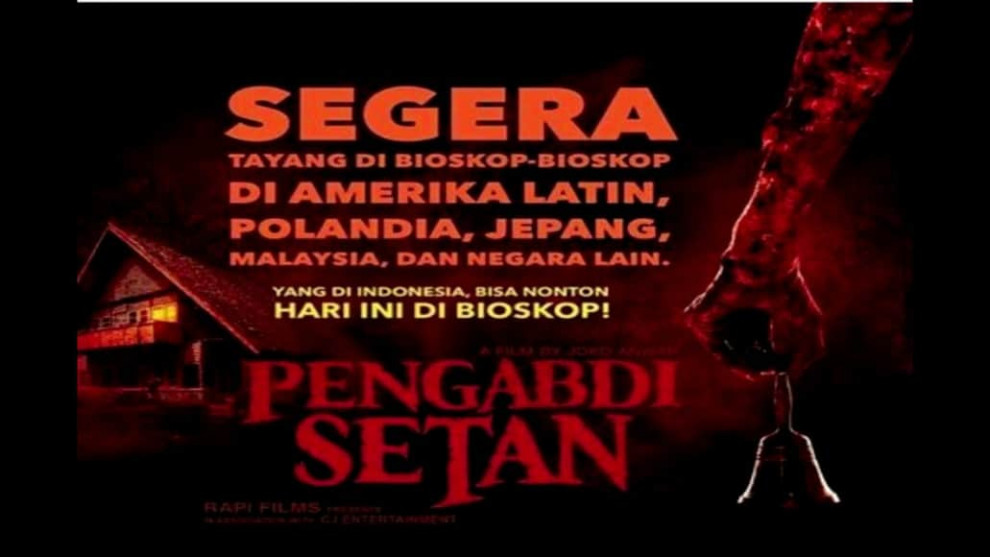(Originally published on cinemapoetica.com entitled “Ketika Negara Tak Lagi Ada: “Pengabdi Setan” dulu dan Sekarang” written by Wiman Rizkidarajat, translatted by Brigitta Isabella)
Horror movies, according to Katinka Van Heeren in Contemporary Indonesian Film: Spirit of Reform and Ghost from the Past, are like a parade which displays—or sometimes questions—many social taboos in our society. Indeed, ghosts, demon, devil or other antagonists in horror movies may reflect the deepest fear hidden at the heart of our society. Horror movies are potent cultural indexes, because they represent the moral signs of the time in a society. The old and the new versions of “Pengabdi Setan” (Satan's Slave) are the case in point.
Here are the things to consider. The first version of “Pengabdi Setan”, directed by Sisworo Gautama Putra, was released in 1980. During that time, the New Order regime (1967-1998) was playing a dominant role in formulating and emphasizing myths that live in Indonesian society, as a mean to control people. From the demonization of communism with the production of the infamous propaganda film “Pengkhianatan G30S/PKI” (Treachery of G30S/PKI, 1984) to the, literally, vulgar display of dead bodies on the street (1983-1985)—fears were vertically produced.
Fast forward to 2017, Joko Anwar, the director of the new version of “Pengabdi Setan” , is surrounded by different social conditions. The State still holds a little bit of power in reproducing myths in society, but now, millions of people are ready to challenge it. After the Reformasi era in 1998, the rise of democracy has not only returned the right for free speech to the people, but also made them able to reproduce their own myths. Fears are now horizontally produced.
The Good-Bad Morality
In the 1980 version of “Pengabdi Setan”, the display of social taboos was performed by the film characters. Munarto was depicted as a father, the head of the family who abandoned his religious responsibility. He prioritized too much his career and became an inadequate single parent. The rest of Munarto's family members were also displaying social taboos. Rita, the first daughter in the family, was going around from party to party with her boyfriend, Herman. Tomy, the youngest son who was disturbed and haunted by his mother's ghost, was resorting to black magic instead of finding peace through religion. In Indonesian society, these would be the god-awful package of social taboos, both in the mortal and the immortal worlds.
Munarto felt that the root of his family problems was the absence of the mother figure. So he hired Darminah, a domestic worker who did not solve any of the problem and instead, became the new source of troubles for the family.
Munarto's family religious preference should not be anyone's business. It was their personal affairs with God, not with other human beings, like Darminah, for example. The film's story did not unfold through logical motives, like the psychology of revenge or economical motives—which could be the case since Munarto came from a high class background. Instead, the film was only following the homogenization of moral discipline enforced by the government.

In the early 1980s, the Badan Film Nasional (National Body of Film) formulated an ethical code of Indonesian film production and organized several other committees to enforce the ethical code. One of the committee's requirements, was that Indonesian films should follow the first principle of Pancasila (the foundational philosophical theory of Indonesian state), which is the belief in the one and only God.
The rule had an impact on the way the storyline in Indonesian films was produced. Simplification of logic. One of them was the polarization between the good and the bad through the reproduction of social taboos. When the good and the bad were conflicting, the good had to win over the bad through the mechanical emergence of the figure of savior who suddenly came in, just like deux ex machina. In most of Indonesian films, the savior would be Kyai, an Islamic male leadership figure.
In the 1980 version of “Pengabdi Setan”, there were a lot of plot holes in the storyline and the film was at best a parade of social taboos. Darminah brought so many complicated conflicts to the family. From the strange case of death around Munarto's family to the zombie attack—all were solved by the appearance of the kyai, which is the symbol of the simplification of logic enforced by the State.
New Logic
In his version of “Pengabdi Setan” , Joko Anwar has brought an exceptional change to the storyline by adding new logics to fill plot holes in the previous version. New logics mean new conflicts, although the foundational story of the new “Pengabdi Setan” is still based on social taboos with the necessary re-contextualization for the present audiences.
The social taboos in Joko Anwar's version were displayed gradually, and at the end of the day, the social taboos were forced to look like they were all interrelated. The first taboo was present when the Father told the ustadz (religious scholar) who led the burial ceremony of his wife, that he and his family did not perform shalat (Islamic prays).
When the ghost of Ibu (the Mother) was starting to haunt the family's three children—Rini, Toni and Bondi—the film presented another taboo: the unblessed marriage of the couple by the Father's mother and the mysterious ritual that the Mother performed in order to get a child. The latter fact was revealed through the grandmother's best friend, Budiman, who told Rini that her mother was joining a satanic fertility ritual to get pregnant.
The taboos in Joko Anwar's “Pengabdi Setan” were more realistic than the older version of the film. The audience were not presented with a collage of scary scenes throughout the film without knowing the real reason why the ghost of the Mother kept on haunting the family. Religious symbols still appeared through the figure of ustadz, but he was not the source of moral code in the film's world. The ustadz was depicted as an ordinary human beingm who had no special differences from the other individuals around the family.
The ustadz was not positioned as the hero of the story. Instead, he only appeared in the story to link Rini and Hendra, the ustadz's son, who claimed that he is “open to new theories.” Rini and Rendra developed a strong relationship and every act they did together, from investigating the cemetery to meeting with Budiman, always came with a new momentum in the film's story. Apparently, all the prayers and suggestions from the ustadz to bring the family closer to God had no effect at all in the story.
The ustadz being an ordinary human being was once again emphasized when his son was killed in a strange road accident. The ustadz believed that Rini was the cause of his son's sudden death, so he decided to stop helping the family's horror problem. The peak was when the ustadz was killed by another figure in the story. He could not help anyone because he was not even able to help himself.
Inconsistent
Although the storyline of the new version of “Pengabdi Setan” is better than the older one, there are still some plot holes. Joko Anwar seemed unable to stop his exploration on social taboos in the story and as a result, there were some parts which had unfinished information, and even betrayed the initial logics of the film.
An example of the unfinished information is when the Father asked the Mother to “pity her children” at the beginning of the film, as we never know the full conversation until the end of the movie. However, through other dialogues in the development of the story, we know that both the Father and the Mother understood the tragic consequences of the satanic fertility ritual. Even if we tried to make sense that scene with Rini's attempt to meet Budiman, we still could not trace whether the Mother's decision to perform the ritual was based on a consensus with the Father or by her own decision.
Another example is when Rini and Toni received Budiman's article revision on the story he wrote about the occultism. Tony tried to convince everyone that he had another proof to support Budiman, which is a photo of his Mother surrounded by strange people who appeared in the Mother's concert. He did this without any hesitation, although the photo album was stored in their living room where the conversation took place. Magic!
“Pengabdi Setan” is not consistent with its own internal logic. The ghost was first depicted as an invisible specter but then suddenly it became a solid creature with a human-like body and could be hindered from going through a door.
“Pengabdi Setan” by Joko Anwar, however, should be acclaimed as a great attempt to elevate the standard of Indonesian horror films. There's a rumor that Joko Anwar will made a sequel to the film, and if that is true, we may find explanations of plot holes in the present film. For now, to judge the film as a single form, “Pengabdi Setan”'s downfall is caused not by the State's mandatory logic but instead by the logic of the film's director.


















